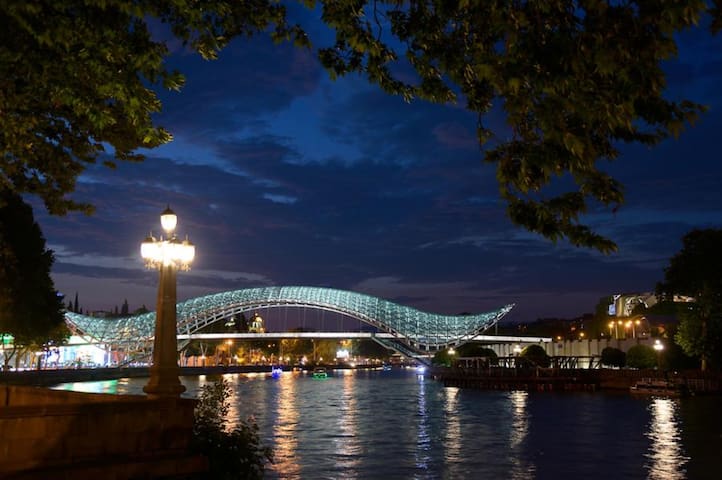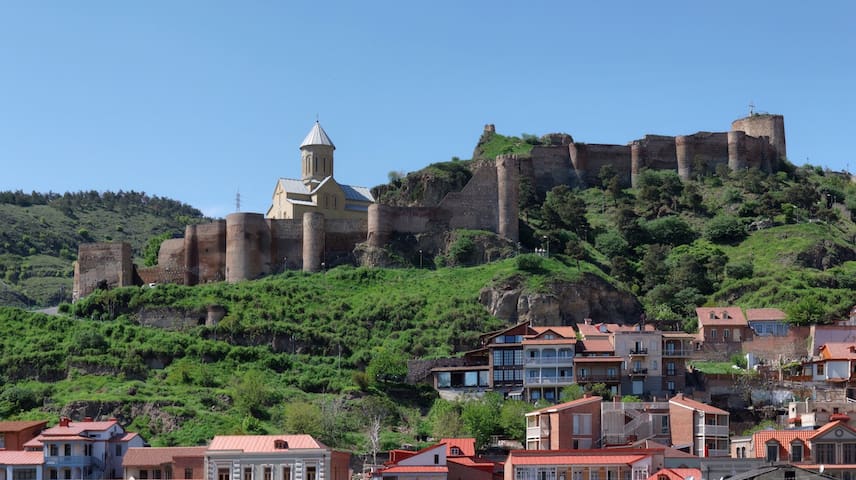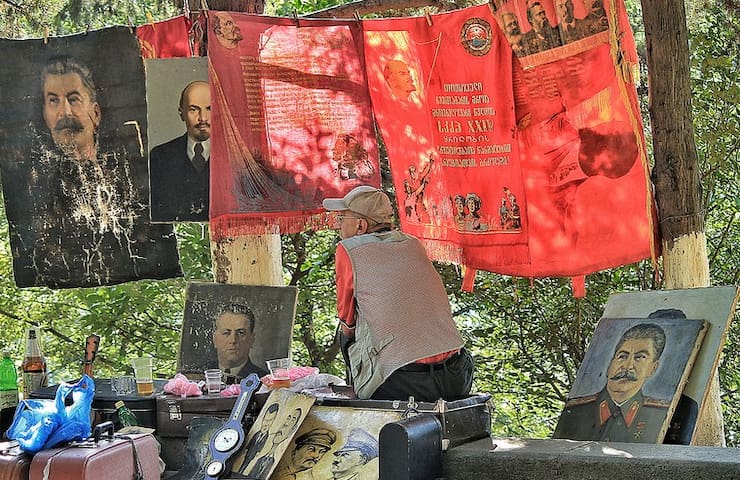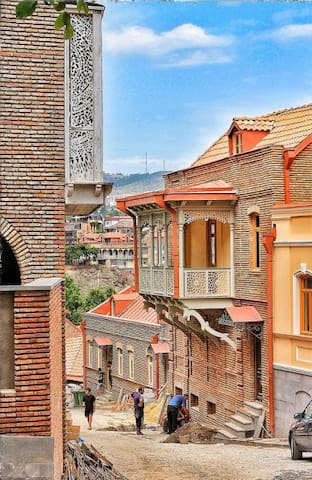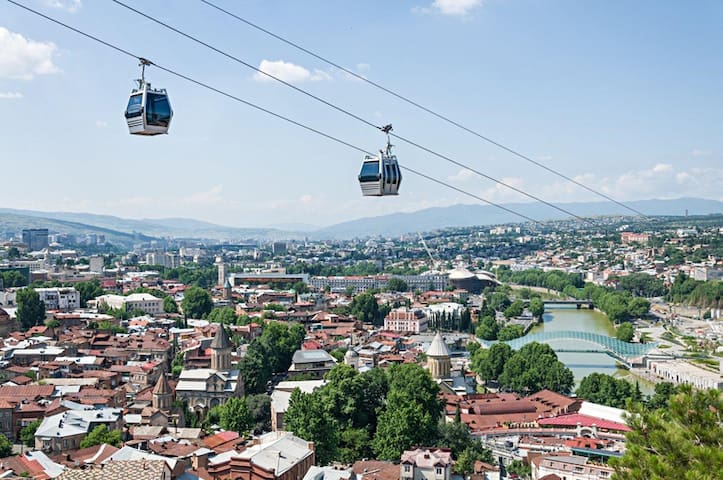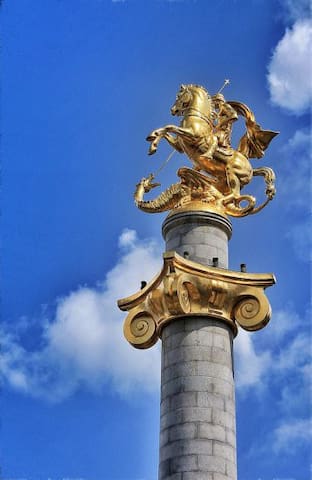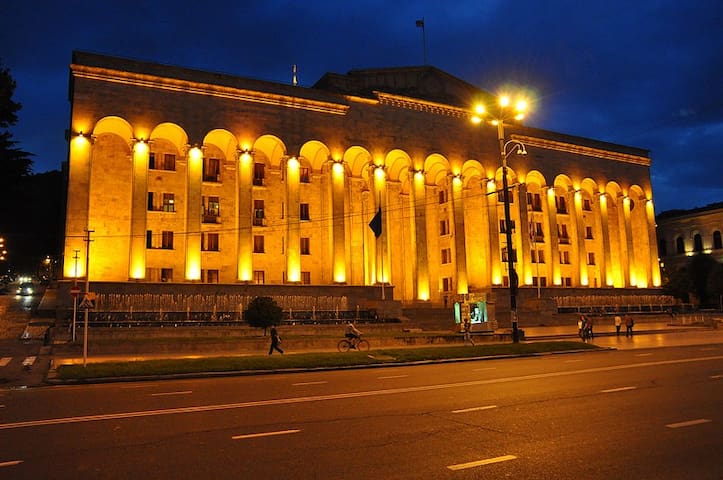Sightseeing in Tbilisi
The newest bridge in Tbilisi, opened in 2010 is made of steel and glass, it is pedestrian so called Peace Bridge. Nowadays one of the controversial symbols of "modern" Tbilisi.
181 personas locales recomiendan
The Bridge of Peace
The Bridge of PeaceThe newest bridge in Tbilisi, opened in 2010 is made of steel and glass, it is pedestrian so called Peace Bridge. Nowadays one of the controversial symbols of "modern" Tbilisi.
Also called the Mother Fortress of Tbilisi, Narikala is an ancient symbol of Tbilisi’s defence. The fortress was established in the 4th century, around the period when the city itself was founded. It was then known as Shuris-tsikhe (Invidious Fort). The name Narikala is said to derive from a Persian word for citadel, but another theory says was the name that Mongols used, meaning “little fortress”. It was expanded considerably by the Arabs during the 7th and 8th centuries. The Arabs built the Emir’s palace within its walls. King David further extended the Builder the fortress in th 11th century. Most of the existing fortifications date from the 16th and 17th centuries. In 1827 it was damaged by an earthquake and was not resorted. St. Nikolos church, inside the fortress walls, dates from the 12th century. It was renovated in 1996. Narikala offers you some of the best panoramas of the city.
438 personas locales recomiendan
Narikala Fortress Legend
Also called the Mother Fortress of Tbilisi, Narikala is an ancient symbol of Tbilisi’s defence. The fortress was established in the 4th century, around the period when the city itself was founded. It was then known as Shuris-tsikhe (Invidious Fort). The name Narikala is said to derive from a Persian word for citadel, but another theory says was the name that Mongols used, meaning “little fortress”. It was expanded considerably by the Arabs during the 7th and 8th centuries. The Arabs built the Emir’s palace within its walls. King David further extended the Builder the fortress in th 11th century. Most of the existing fortifications date from the 16th and 17th centuries. In 1827 it was damaged by an earthquake and was not resorted. St. Nikolos church, inside the fortress walls, dates from the 12th century. It was renovated in 1996. Narikala offers you some of the best panoramas of the city.
Mtatsminda Mountain
The sulphur baths are intimately connected with Tbilisi. It is said that the hot springs are why the city was built here. High in sulphurs and other minerals, with a constant temperature of 38C to 40C, the waters have long been used as a therapeutic aid for a range of ailments including skin conditions and arthritis.
Naturally fed public sulphur baths have been essential part of life in Tbilisi for centuries. Citizens would spend their leisure time relaxing here, even giving formal dinner-parties in the baths. The local match-makers could sometimes be bribed to allow illicit glimpses of naked bodies.
Alexander Pushkin was just one of many famous people to have taken the waters, and he certainly enjoyed the experience: 'I have never encountered anything more luxurious than this Tbilisi bath', he wrote.
Located on Abano (bath) Street the underground public bath houses in use today are characterised from the outside by their rows of low cupola. The oldest is Erekle's Bath, whilst the most externally ornate is 'Chreli Abano' with its towering facade of decorated tiles.
235 personas locales recomiendan
Abanotubani
The sulphur baths are intimately connected with Tbilisi. It is said that the hot springs are why the city was built here. High in sulphurs and other minerals, with a constant temperature of 38C to 40C, the waters have long been used as a therapeutic aid for a range of ailments including skin conditions and arthritis.
Naturally fed public sulphur baths have been essential part of life in Tbilisi for centuries. Citizens would spend their leisure time relaxing here, even giving formal dinner-parties in the baths. The local match-makers could sometimes be bribed to allow illicit glimpses of naked bodies.
Alexander Pushkin was just one of many famous people to have taken the waters, and he certainly enjoyed the experience: 'I have never encountered anything more luxurious than this Tbilisi bath', he wrote.
Located on Abano (bath) Street the underground public bath houses in use today are characterised from the outside by their rows of low cupola. The oldest is Erekle's Bath, whilst the most externally ornate is 'Chreli Abano' with its towering facade of decorated tiles.
The clock tower
13 Ioane Shavteli StThis extraordinary flea market will keep you entertained for hours. There is a mesmerising assortment of antiques, jewellery and bric-a-brac on sale. In the tough days of Perestroika and the early years of independence, the Dry Bridge is where hard-up citizens of Tbilisi would come to sell their possessions in order to make a little cash. For some people that is still the case today, though for others this is their main business. Everything is laid out on the ground, often carefully arranged on on sheets of material, other times it is a haphazard collection. One person might be trying to sell you twenty-year-old batteries or an old toothbrush, while their neighbour will be touting antique amber and silver jewellery. If you want to buy anything remember to haggle. Prices may be inflated, especially for tourists. Open daily if the weather is good, from 10:00 - 17:00. At weekends there are usually more sellers, but more tourists too.
198 personas locales recomiendan
Dry Bridge Market
This extraordinary flea market will keep you entertained for hours. There is a mesmerising assortment of antiques, jewellery and bric-a-brac on sale. In the tough days of Perestroika and the early years of independence, the Dry Bridge is where hard-up citizens of Tbilisi would come to sell their possessions in order to make a little cash. For some people that is still the case today, though for others this is their main business. Everything is laid out on the ground, often carefully arranged on on sheets of material, other times it is a haphazard collection. One person might be trying to sell you twenty-year-old batteries or an old toothbrush, while their neighbour will be touting antique amber and silver jewellery. If you want to buy anything remember to haggle. Prices may be inflated, especially for tourists. Open daily if the weather is good, from 10:00 - 17:00. At weekends there are usually more sellers, but more tourists too.
Sitting at the foot of the imposing hill capped by the Narikala Fortress and climbing the slopes is Tbilisi Old Town, a labyrinth of narrow streets where wooden balconies look down from old brick-build homes. Doorways lead to hidden courtyards an ancient vines climb to the skies using anything vertical for support. Parts have been comprehensively renovated, arguably a little too enthusiastically, so that some streets look like a Disney film set, though far more of these twisting alleys are untouched. They are ramshackle, cracked and crumbling but delightful, enchanting, picturesque and real. The style is a mix of two influences, the tight winding streets of an Asian or Arabic town interwoven with European, classical Russian and Art Nouveau architecture. The northern edge is the recently renovated Abanotubani area, famous for its Sulphur Baths and Meidani square with its many restaurants. Old Town’s main artery is Kote Abkhazi Street (formerly Leselidze) which connect Meidani with Freedom Square. In the North East corner, between Leselidze and the river, is Chardeni, a small area backed with bars restaurants, nightclubs and cafes, shoulder to shoulder along a series of pedestrian streets. To the west, Old Town melts into Sololaki area, a lovely and fascinating place to wander around, take photographs and explore Tbilisi.
398 personas locales recomiendan
Dzveli Tbilisi
Sitting at the foot of the imposing hill capped by the Narikala Fortress and climbing the slopes is Tbilisi Old Town, a labyrinth of narrow streets where wooden balconies look down from old brick-build homes. Doorways lead to hidden courtyards an ancient vines climb to the skies using anything vertical for support. Parts have been comprehensively renovated, arguably a little too enthusiastically, so that some streets look like a Disney film set, though far more of these twisting alleys are untouched. They are ramshackle, cracked and crumbling but delightful, enchanting, picturesque and real. The style is a mix of two influences, the tight winding streets of an Asian or Arabic town interwoven with European, classical Russian and Art Nouveau architecture. The northern edge is the recently renovated Abanotubani area, famous for its Sulphur Baths and Meidani square with its many restaurants. Old Town’s main artery is Kote Abkhazi Street (formerly Leselidze) which connect Meidani with Freedom Square. In the North East corner, between Leselidze and the river, is Chardeni, a small area backed with bars restaurants, nightclubs and cafes, shoulder to shoulder along a series of pedestrian streets. To the west, Old Town melts into Sololaki area, a lovely and fascinating place to wander around, take photographs and explore Tbilisi.
Tbilisi’s Opera House has a history spanning more than 160 years. Named after famous Georgian composer and founder of modern Georgian music, Zakaria Paliashvili, the project was initiated by the Russian Tsar’s viceroy to the Caucasus - Mikhail Vorontsov. Supposedly, the initiative to build the opera house was seen as an attempt to soothe unrest in Georgia in 1832, and give credit to the cultural policies of the Russian Empire in the eyes of the restive Georgian aristocracy. French writer Alexandre Dumas visited Tbilis in 1858 - 7 years after the completion of the Opera House - and wrote in his book, “Caucasus”, that he had “never seen any hall more spectacular than the one of Tbilisi Opera House in my entire life.” Throughout its history, the Opera House has sustained two raging fires, one in 1874 and a second in 1973. After six years of renovation works, the Tbilisi Opera House opened yet again in January of 2016, and hosted a performance of “Abesalom and Eteri” - one of Zakaria Paliahsvili’s most famous traditional opera scores. Step inside to be transported into a world long gone, but make sure to call ahead before going.
303 personas locales recomiendan
Opera and Ballet Theatre of Tbilisi
25 Shota Rustaveli AveTbilisi’s Opera House has a history spanning more than 160 years. Named after famous Georgian composer and founder of modern Georgian music, Zakaria Paliashvili, the project was initiated by the Russian Tsar’s viceroy to the Caucasus - Mikhail Vorontsov. Supposedly, the initiative to build the opera house was seen as an attempt to soothe unrest in Georgia in 1832, and give credit to the cultural policies of the Russian Empire in the eyes of the restive Georgian aristocracy. French writer Alexandre Dumas visited Tbilis in 1858 - 7 years after the completion of the Opera House - and wrote in his book, “Caucasus”, that he had “never seen any hall more spectacular than the one of Tbilisi Opera House in my entire life.” Throughout its history, the Opera House has sustained two raging fires, one in 1874 and a second in 1973. After six years of renovation works, the Tbilisi Opera House opened yet again in January of 2016, and hosted a performance of “Abesalom and Eteri” - one of Zakaria Paliahsvili’s most famous traditional opera scores. Step inside to be transported into a world long gone, but make sure to call ahead before going.
Opened in 2012, a cable car connects Rike Park on the left bank of the Mtkvari river with Narikala Fortress. For only 1 Lari you can kill two birds with one stone – gaze at the fantastic 360-degree views of the city from the large windows of the car and have an easy ride to the top of the hill. The ride only takes a couple of minutes, which is our only complaint, because with such beautiful views to take in, the trip goes far too fast. We really hope that the officials in charge of the cable car read this and heed our plea to slow it down. When you get out at the hill-top station turn right to the Kartlis Deda statue, or left to the Narikala Fortress. A tip: wait for the car with a sign saying 'only 5 people allowed': it has a glass floor. The cable car accepts Metro cards.
12 personas locales recomiendan
tbilisi cable car
Opened in 2012, a cable car connects Rike Park on the left bank of the Mtkvari river with Narikala Fortress. For only 1 Lari you can kill two birds with one stone – gaze at the fantastic 360-degree views of the city from the large windows of the car and have an easy ride to the top of the hill. The ride only takes a couple of minutes, which is our only complaint, because with such beautiful views to take in, the trip goes far too fast. We really hope that the officials in charge of the cable car read this and heed our plea to slow it down. When you get out at the hill-top station turn right to the Kartlis Deda statue, or left to the Narikala Fortress. A tip: wait for the car with a sign saying 'only 5 people allowed': it has a glass floor. The cable car accepts Metro cards.
Is the heart and centre of the city and the ideal place to get your bearings. Many hotels and hostels are close by as well as a lot of banks and offices. There is a Tourist Information right next to the bus stop. Freedom Square also marks one end of the Old Town. There're construction works at the moment on one edge of the square which makes the area less pleasant than usual. The golden statue of Saint George on top of a pillar in the centre of the square was erected after the Rose Revolution in 2005.
12 personas locales recomiendan
Freedom Square
Freedom SquareIs the heart and centre of the city and the ideal place to get your bearings. Many hotels and hostels are close by as well as a lot of banks and offices. There is a Tourist Information right next to the bus stop. Freedom Square also marks one end of the Old Town. There're construction works at the moment on one edge of the square which makes the area less pleasant than usual. The golden statue of Saint George on top of a pillar in the centre of the square was erected after the Rose Revolution in 2005.
The oldest church in Tbilisi, dating back to the sixth century. Its design differs from the typical later temples. There are magnificent frescoes inside, some dating back almost 400 years.
105 personas locales recomiendan
Anchiskhati Basilica
11 Ioane Shavteli StThe oldest church in Tbilisi, dating back to the sixth century. Its design differs from the typical later temples. There are magnificent frescoes inside, some dating back almost 400 years.
In 1900 the city government commissioned the Belgian engineer, Alphonse Roby, to construct a funicular. The 500 metres long line was opened in March 1905. It consisted of three stations, the lower on today’s Chonquadze street in the city, the Pantheon stop near the Mtatsminda Pantheon, and Mtatsminda, at the top of mountain. It was closed in 2000 following an accident, but reopened in 2012 after a comprehensive reconstruction project that renovated the stations and replaced the drive mechanism, rails, cars and safety equipment. A single ride is 2 Lari, but you also need to purchase a rechargeable card (valid also for Mtatsminda Park) which costs 2 Lari and is not refundable. Cars run every 10 minutes from 09:00 to 04:00.
280 personas locales recomiendan
Funicular Complex
9 ქაქუცა ჩოლოყაშვილის ქუჩაIn 1900 the city government commissioned the Belgian engineer, Alphonse Roby, to construct a funicular. The 500 metres long line was opened in March 1905. It consisted of three stations, the lower on today’s Chonquadze street in the city, the Pantheon stop near the Mtatsminda Pantheon, and Mtatsminda, at the top of mountain. It was closed in 2000 following an accident, but reopened in 2012 after a comprehensive reconstruction project that renovated the stations and replaced the drive mechanism, rails, cars and safety equipment. A single ride is 2 Lari, but you also need to purchase a rechargeable card (valid also for Mtatsminda Park) which costs 2 Lari and is not refundable. Cars run every 10 minutes from 09:00 to 04:00.
This important example of Soviet Georgian architecture situated on Rustaveli avenue was the former home of the USSR’s government in Georgia. The oldest part of the building was erected in 1953. It is faced with 16 columns, representing the 16 Soviet states of the USSR. In 2011 the Georgian parliament voted to remove Soviet icons from public display and a lot of carved hammers and sickles and other Soviet symbols were removed from the facades of old buildings, including the Parliament itself. The actual Parliament of Georgia has moved to Kutaisi, where a new home was built for it between 2011-2012.
39 personas locales recomiendan
Parliament of Georgia
8 Shota Rustaveli AveThis important example of Soviet Georgian architecture situated on Rustaveli avenue was the former home of the USSR’s government in Georgia. The oldest part of the building was erected in 1953. It is faced with 16 columns, representing the 16 Soviet states of the USSR. In 2011 the Georgian parliament voted to remove Soviet icons from public display and a lot of carved hammers and sickles and other Soviet symbols were removed from the facades of old buildings, including the Parliament itself. The actual Parliament of Georgia has moved to Kutaisi, where a new home was built for it between 2011-2012.
According to legend, the first church on this site was constructed by King Vakhtang Gorgasali in the fifth century and has been rebuilt several times since. Its three-tiered church tower was constructed in 15th century and renovated in the 18th century. Its walls are covered with beautiful frescoes. Visit on a Sunday morning and enjoy the signing of the boys' choir.
110 personas locales recomiendan
Zion cathedral
3 Sioni StAccording to legend, the first church on this site was constructed by King Vakhtang Gorgasali in the fifth century and has been rebuilt several times since. Its three-tiered church tower was constructed in 15th century and renovated in the 18th century. Its walls are covered with beautiful frescoes. Visit on a Sunday morning and enjoy the signing of the boys' choir.
Restaurants
The menu in this restaurant is heavenly delicious, the best example of gastronomy excellence. Mix of traditions and modern soul. Tasty results of extraordinary experiments. The restaurant is located in a big house with red brick walls. Comfy, cozy, artsy interior, lovely, photogenic, nicely decorated garden, friendly, attentive and knowledgeable staff, fast service.
191 personas locales recomiendan
Shavi Lomi
28 Zurab Kvlividze StThe menu in this restaurant is heavenly delicious, the best example of gastronomy excellence. Mix of traditions and modern soul. Tasty results of extraordinary experiments. The restaurant is located in a big house with red brick walls. Comfy, cozy, artsy interior, lovely, photogenic, nicely decorated garden, friendly, attentive and knowledgeable staff, fast service.
Salobie Bia is a small artsy restaurant that offers traditional meals with of Western Georgia and is set in a lovely decorated art place, surrounded by paintings, selected old furniture mixed with modern objects. They sell delicious home made green Ajika (chili) in small jars - makes a perfect souvenir.
59 personas locales recomiendan
Salobie Bia
17 Shota Rustaveli AveSalobie Bia is a small artsy restaurant that offers traditional meals with of Western Georgia and is set in a lovely decorated art place, surrounded by paintings, selected old furniture mixed with modern objects. They sell delicious home made green Ajika (chili) in small jars - makes a perfect souvenir.
Café Littera
13 Ivane Machabeli St
